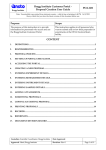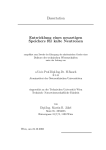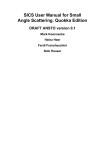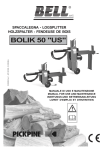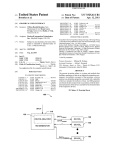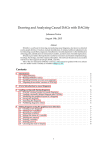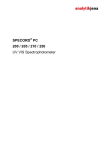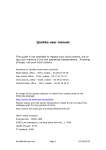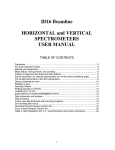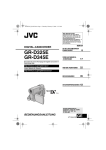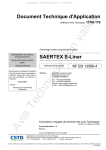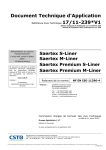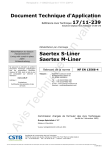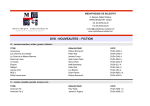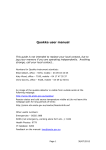Download kookaburra
Transcript
KOOKABURRA The Ultra-Small-Angle Neutron Scattering (USANS) Instrument KOOKABURRA USER MANUAL KOOKABURRA Table of Contents 1 TECHNICAL DESCRIPTION .....................................................................................................................................3 1.1 INTRODUCTION ...................................................................................................................................................... 3 1.2 ABOUT USANS ........................................................................................................................................................ 3 1.2.1 USANS TECHNIQUES ..................................................................................................................................... 4 1.2.2 HOW WE DECIDED WHAT TYPE OF LOW-Q INSTRUMENT TO BUILD ........................................................... 4 1.3 THE KOOKABURRA USANS INSTRUMENT ............................................................................................................... 5 1.3.1 INSTRUMENT CONCEPT ................................................................................................................................ 6 1.3.2 INSTRUMENT PERFORMANCE..................................................................................................................... 10 1.3.3 INSTRUMENT LAYOUT................................................................................................................................. 11 1.3.4 INSTRUMENT COMPONENTS ...................................................................................................................... 13 1.3.4.1 1.3.4.2 1.3.4.3 1.3.4.4 1.3.4.5 1.3.4.6 1.3.4.7 1.3.4.8 1.4 2 COLD-NEUTRON GUIDE CG3 ............................................................................................................................... 13 PREMONOCHROMATOR ASSEMBLY ................................................................................................................... 14 BERYLLIUM FILTER .............................................................................................................................................. 16 SAMPLE SHUTTER AND BEAM STOP ................................................................................................................... 17 CHANNEL-CUT MONOCHROMATOR/ANALYSER STAGES.................................................................................... 17 SLIT SYSTEMS ...................................................................................................................................................... 20 SAMPLE STAGE ................................................................................................................................................... 20 DETECTOR SYSTEM AND DATA TREATMENT/MANAGEMENT ............................................................................ 22 REFERENCES ......................................................................................................................................................... 24 USER GUIDE FOR INSTRUMENT OPERATION ....................................................................................................... 25 2.1 PRELIMINARIES ..................................................................................................................................................... 25 2.1.1 WAVELENGTH OPTIONS .............................................................................................................................. 25 2.1.2 SAMPLE REQUIREMENTS ............................................................................................................................ 25 2.1.3 SAMPLE MOUNTING ................................................................................................................................... 27 2.1.4 SAMPLE ENVIRONMENT ............................................................................................................................. 28 2.2 OPERATION OF KOOKABURRA ............................................................................................................................. 28 2.3 ILLUSTRATED STEP-BY-STEP INSTRUCTIONS ........................................................................................................ 29 2 KOOKABURRA 1 1.1 TECHNICAL DESCRIPTION INTRODUCTION This document provides a comprehensive technical description of the ultra-small-angle neutron scattering (USANS) instrument KOOKABURRA installed at the ANSTO OPAL reactor, where a brief overview of USANS techniques and applications is followed by a general description of the layout and performance of KOOKABURRA. 1.2 ABOUT USANS Modern materials science and engineering rely increasingly on a detailed knowledge of the interplay between structure and material properties, and Modern materials science and neutron scattering is a key tool for obtaining structural engineering rely increasingly on a information. detailed knowledge of the In small-angle neutron scattering (SANS) experiments, microstructure and interactions in neutrons are assumed to be elastically scattered by a soft and hard materials. sample, and the resulting scattering pattern can be analysed to provide information about the size, shape, orientation, and number density of scattering entities within the sample. SANS can provide a unique insight into the hierarchical structures of materials because the range of accessible realspace length scales D is relatively large, ranging between 10 Å and a few 1,000 Å, with the corresponding scattering vector magnitudes Q ≅ 2π/D ranging between ∼1 and ∼10-3 Å-1 [Q = |Q|= (4πλ) sin(θ/2), where θ is the scattering angle and λ is the wavelength of the incident neutrons]. In many experimental cases, it is desirable to extend this experimentally The USANS technique measurable range to length scales up to D = 105 Å = 10 µm, allows determination of corresponding to Q ≅ 10-4 Å-1, the "ultra-low-Q" region accessible microstructures (size, through ultra-small-angle neutron scattering, USANS. shape, orientation, etc.) of complex systems USANS is useful for studies of pores and cracks in rocks, cement or covering length scales engineering materials, very large biological or polymer molecules or in the range of ∼100 nm macromolecular assemblies, and mesoscopic magnetic particles. The to ∼10µm. range of interest includes bacteria, blood, cements, clays, clusters in metals, coals, colloids, complex fluids, emulsions, foams, food, gels, granular materials, hydrogels, membranes, micellar systems, minerals and mineral processing, nanocomposites, nanotechnology, phase transitions, polymer blends, polymers, porous materials, powders, precipitates, proteins, rocks, thin metallic or organic films, viruses, etc. 3 KOOKABURRA Fig. 1 - Example of three high-level research areas that benefit from applying the USANS technique, see three blue circles. Listed next to them are associated areas of interest. It follows that there is a broad range of materials that may be studied by USANS. 1.2.1 USANS techniques In recent years two types of ultra-low-Q neutron scattering techniques have been developed, namely the double-crystal USANS method, which uses perfect silicon (Si) crystals in Bragg reflection, and spin-echo SANS (SESANS), in which the spin precessions of a polarised beam of neutrons are used to encode the scattering angle to very high precision. Both techniques are only sensitive to scattering in one direction, while in the perpendicular direction the measurements are averaged over the possible wavevector transfers, i.e. they measure scattered intensity from the sample with excellent angular resolution in one direction of a few arc seconds but with a large acceptance in the perpendicular direction of a few degrees, which is described as "slit smearing". 1.2.2 How we decided what type of low-q instrument to build At the ANSTO workshop "Pushing Small-Angle Neutron Scattering at OPAL to Smaller Q" held in November 2007 (ANSTO, 2007) it was concluded that there is a strong scientific case with broad scientific application and a pre-existing low-Q user community in Australia. Two options for a new low-Q instrument to be built at OPAL were defined: 4 KOOKABURRA • Classical Double-Crystal USANS This method, also known as Bonse-Hart method (Bonse & Hart, 1965), uses two perfect Si crystals in Bragg reflection as collimators. • Spin-Echo SANS (SESANS) This recently developed method uses spin precessions of a polarised neutron beam to encode the scattering angle to very high precision. To help decide on the most appropriate type of instrument for the Australian community, we have carried out a detailed comparison of the capabilities of both methods. Based on experimental round-robin test measurements as well as analytical calculations, we analysed the strengths, weaknesses and experimental limitations, and investigated possible performance gains for both setups at OPAL. • Round-Robin Neutron Scattering Measurements Round-robin test measurements have been performed on a set of standard samples using the BT-5 double-crystal USANS instrument at NIST (Barker et al., 2005) and the SESANS instrument at Delft (Rekveldt et al., 2005), respectively, to experimentally determine the advantages and disadvantages of both techniques. The standard samples consisted of polystyrene microspheres featuring different particle diameters and various scattering powers. • Instrument Performance Estimations Monte Carlo and analytical calculations helped estimate the performances of either instrument type, double-crystal USANS and SESANS, being installed at OPAL. Although both techniques are applicable for studying large-scale objects they have different strengths, and it follows that different science will be done on these two instruments which are complementary rather than competitive. A survey of the Australian large-scale structures science community revealed that a rather large range of scientific problems needs to be covered by the new instrument. According to the experts, double-crystal USANS is better suited for investigating the widest possible range of sample properties and the widest range of sample scattering powers. A paper titled "DCD USANS and SESANS: a comparison of two neutron scattering techniques applicable for the study of large-scale structures" has been published (Rehm et al., 2013). 1.3 THE KOOKABURRA USANS INSTRUMENT The KOOKABURRA USANS instrument is based on the classical Bonse-Hart [Bonse & Hart, 1965) method, which consists of using two multiple-reflection crystal systems arranged in a nondispersive geometry to achieve a steep decrease in the tails of the perfect crystal diffraction curves. This technique permits the detection of very small angular deviations of the neutron beam after scattering from a sample placed between two channel-cut crystals (Agamalian et al., 1997). In the following we discuss the concept and layout of the KOOKABURRA double-crystal USANS instrument followed by detailed descriptions of the instrument components (Rehm et al., 2013). 5 KOOKABURRA 1.3.1 Instrument concept The central parts of KOOKABURRA are two identical, multi-bounce, channel-cut, perfect Si single crystals (Schwahn et al., 1985), labelled monochromator and analyser (see Fig. 2) mounted on a single optical bench. When the monochromator and analyser crystals are perfectly aligned to each other (analyser rotation angle θ = 0˚), the incident neutron beam is totally reflected into the main detector. Fig. 2 - Schematic layout of the double-crystal USANS principle. The main instrument components are two identical, perfect silicon (Si) channel-cut crystals placed in front (labelled monochromator) and after the sample (labelled analyser), respectively. During the experiment the analyser crystal is rotated and thus a very sharp rocking curve profile recorded. During the experiment neutron scattering intensities are measured as a function of the momentum transfer Q (or scattering angle θ) at a time, i.e. only the small-angle scattering corresponding to the same angle θ is reflected. Minute deviations in the neutron beam direction after scattering by the sample are observed as a broadening of the double-crystal analyser rocking curve (see Fig. 3). 6 KOOKABURRA Fig. 3 - In a typical double-crystal USANS experiment rocking curves are measured with and without a sample material being present. Small-angle scattering caused by the sample material results in a broadening of the initially sharp rocking curve profile, and the difference between these two rocking curves will be analysed. Because the channel-cut crystals are perfect, Bragg reflection of a particular wavelength λ is restricted to a very narrow angular range of neutron trajectories that fall within the so-called Darwin width, which is typically a few arc seconds (Agamalian et al., 1997: Barker et al., 2005). Within this uncertainty, neutron trajectories are completely correlated with neutron wavelength. The Bonse-Hart USANS technique can use a relatively wide range of wavelength/divergence-angle combinations simultaneously, which enhances the flux on sample without sacrificing the Qresolution. The high angular resolution required for double-crystal USANS experiments is enhanced through multiple reflections of the neutron beam before and after the sample. KOOKABURRA utilises quintuple bounces inside the perfect Si channel-cut crystals. Optimisation of the instrument with regards to determining the most efficient type of premonochromator crystal, channel-cut crystals, and scattering geometry has been discussed elsewhere (Freund & Rehm, 2011). Note that in a traditional SANS experiment the optimal sample scatters between 5% and 20% of the incident neutron beam. For the case of less than 5% scattering, the signal-to-noise ratio might be poor (note that the lower limit depends somewhat on the shape of the scattering curve). For scattering of more than 20% of the beam, the SANS intensity would be strong enough to create noticeable multiple scattering, resulting in a shape-distorted scattering curve. For the strongly scattering samples, an adequate sample optimisation (i.e. a reduction of the scattering) can often be achieved by manipulating the sample via, for example, dilution, reduction in sample thickness or contrast matching. Note that the scattering power of a sample is also proportional to λ2. 7 KOOKABURRA In order to optimally accommodate samples which differ in scattering powers, the versatile KOOKABURRA USANS instrument is designed to allow individual operation at two different wavelengths as illustrated in Fig. 4. Fig. 4 - Schematic layout of the KOOKABURRA double-crystal USANS principle. The perfect Si channel-cut crystals of choice, either Si(111) or Si(311), are rotated into the neutron beam. For details see text. The incident neutron beams are reflected off a highly-oriented pyrolytic graphite (HOPG) premonochromator crystal at a fixed angle of θBragg = 45°, either at λ = 4.74 Å using the HOPG(002) first-order reflection or at λ = 2.37 Å using the HOPG(004) second-order reflection. The expected performances of KOOKABURRA when operating at either wavelength are summarised in Table 1. 8 KOOKABURRA HIGH-INTENSITY MODE HIGH-RESOLUTION MODE Weak Scattering Samples Strong Scattering Samples Wavelength λ = 4.74 Å λ = 2.37 Å Premonochromator HOPG(002) at θBragg = 45° HOPG(004) at θBragg = 45° Beryllium Filter In Out Channel-Cut Crystals Si(111) at θBragg = 49.2° Si(311) at θBragg = 46.4° Full Darwin Width 2∆θD = 21 µrad 2∆θD = 5.4 µrad Minimum Momentum Transfer Qmin = 2.8⋅10 Å Qmin = 1.4⋅10 Å Flux on Sample 190,000 n cm-2 s-1 23,000 n cm-2 s-1 -5 -1 -5 -1 Table 1 - KOOKABURRA Instrument performances expected for operation at two different wavelengths. Note that the precise values for the full width at half-height depend on whether the Darwin or the Ewald solution applies, see e.g. Agamalian et al. (2010). When operating the instrument with 4.74 Å neutrons, two Si(111) channel-cut crystals will be used at a Bragg angle of 49.2°. Also, a beryllium filter will be moved into the beam to remove by scattering neutrons with wavelengths below 4 Å, i.e. to suppress higher-order wavelengths emerging from the premonochromator. When operating the instrument with 2.37 Å neutrons, two Si(311) channel-cut crystals will be used at a Bragg angle of 46.4°, and the beryllium filter will be moved out of the beam. The 4.74 Å wavelength high-intensity operation mode is most appropriate for weakly scattering samples but it should be noted that the four times larger full Darwin width for the 4.74 Å operation of 2∆θD = 21 µrad (compared to a value of 2∆θD = 5.4 µrad for the 2.37 Å operation) results in a poorer resolution at small values of Q (Qmin for 4.74 Å is a factor of two larger than Qmin for 2.37 Å, see Table 1). Note that Qmin is estimated as Qmin ≅ 4π∆θD/λ (Agamalian, 2011). Concerns about multiple scattering for strongly scattering samples can be addressed by switching to the λ = 2.37 Å mode when necessary. Although both the first- and second-order neutrons will reach the channel-cut monochromator crystal when the beryllium filter is moved out of the beam when operating KOOKABURRA at 2.37 Å, the 4.74 Å neutrons will not be further transported through the Si(311) channel-cut crystal set-up. 9 KOOKABURRA 1.3.2 Instrument performance Fig. 5 shows the very sharp rocking curve profiles obtained by using the two different wavelengths available at KOOKABURRA. For the long wavelength option using Si(111) channel-cut crystals with a resulting wavelength of λ = 4.74 Å the full-width-half-maximum value is 0.0015°, for the short wavelength option using Si(311) channel-cut crystals with a resulting wavelength of λ = 2.37 Å the full-width-half-maximum value is 0.0003°, both values are in very good agreement to theoretically expected figures. Fig. 5 - Very sharp rocking curve profiles obtained by using either Si(111) or Si(311) channel-cut crystals on KOOKABURRA. The two different wavelengths and the full-width-half-maximum values of the curves are indicated. 10 KOOKABURRA 1.3.3 Instrument layout KOOKABURRA has been installed at the ANSTO OPAL (Kennedy et al., 2001; Robinson & Kennedy, 2002; Kennedy, 2006) cold-neutron guide CG3 downstream of the EMU backscattering instrument and upstream of the PLATYPUS reflectometer (James et al., 2006, 2011), see Fig. 6. Fig. 6 - Neutron scattering instruments installed at the cold-neutron guide CG3 at the ANSTO OPAL reactor. The general assembly of KOOKABURRA is schematically shown in Fig. 7 while Fig. 8 shows a photo of the instrument during the installation phase. 11 KOOKABURRA Fig. 7 - General assembly of the KOOKABURRA USANS instrument at the ANSTO OPAL cold-neutron guide CG3 with main components indicated. A doubly focusing highly-oriented pyrolytic graphite (HOPG) premonochromator device extracts a monochromatic neutron beam. A beryllium filter can be used to remove by scattering neutrons with wavelengths below 4 Å, if required. A sample shutter allows opening and closing of the neutron beam. The sample position is surrounded by the channel-cut monochromator and analyser stages. The distance between these two stages is variable in order to be able to accommodate any sample environment equipment like cryostats, magnets etc. It follows that the location of the main detector (which needs to be in line with the channel-cut analyser crystal) is variable, too. For detailed descriptions of the main instrument components see sections below. 12 KOOKABURRA Fig. 8 - The KOOKABURRA USANS instrument during the installation phase. 1.3.4 Instrument components 1.3.4.1 Cold-neutron guide CG3 KOOKABURRA utilises neutrons delivered by the OPAL cold-neutron guide CG3. This guide is fed by a hydrogen cold-neutron source 363 mm high × 108 mm wide with a total flux of 1.8×10-13 n cm-2 s-1 at T = 25 K (Kennedy, 2006). CG3 includes straight neutron guide sections with curved neutron guide sections in between (with a radius of curvature of 1.3 km), supermirror coatings of m = 3 at the top and bottom of the neutron guides and m = 2.5 on the sides, a cut-off wavelength of about λ = 0.8 Å, and a beam cross-section 200 mm high × 50 mm wide. The upper 20 mm of CG3 are exclusively used to provide neutrons to the PLATYPUS neutron reflectometer installed downstream of KOOKABURRA. Therefore, the remaining effective beam cross-section for KOOKABURRA is 170 mm high × 50 mm wide. Fig. 9 shows the schematic layout of the KOOKABURRA upstream optics (CG3 neutron guide, premonochromator assembly, beryllium (Be) filter on a translation stage, and the sample shutter). 13 KOOKABURRA Fig. 9 - Schematic layout of the KOOKABURRA upstream optics with main components indicated. 1.3.4.2 Premonochromator assembly About 30 m away from the cold source, a premonochromator crystal has been installed in the white neutron beam exiting the cold-neutron guide CG3 of effective dimensions 170 mm high × 50 mm wide. Its function is to select a monochromatic neutron beam and to focus it onto the sample position, which is located between the channel-cut monochromator and the channel-cut analyser crystal at a nominal distance of 1600 mm from the premonochromator. The schematic layout of the premonochromator assembly, comprising of the premonochromator crystal and tilt and rotation stages for its alignment, is shown in Fig. 10. Fig. 10 - Left: Schematic layout of the KOOKABURRA premonochromator assembly with main components indicated. Right: Premonochromator crystal mounting. 14 KOOKABURRA The premonochromator crystal material is highly-oriented pyrolytic graphite (HOPG) with dimensions 82.5 mm (horizontal) × 168 mm (vertical) × 1.8 mm thick. Since the premonochromator is doubly focusing (i.e. it is curved both horizontally and vertically), it consists of a composite of five vertical arrays of 17 HOPG pieces, each piece with dimensions 16.5 mm (horizontal) × 10 mm (vertical). The pieces were mounted on a silicon support plate (SESO, http://www.seso.com) approaching the nominal curvatures with a sagittal (vertical) radius of curvature of 2.27 m, and a meridional (horizontal) radius of curvature of 4.54 m, using indium metal as bonding material. The Bragg angle of the assembled premonochromator crystal is fixed at 45°. The crystal assembly was characterised on the double-crystal test instrument T13C of the Institute Laue-Langevin (ILL) in Grenoble, France (Boeuf et al., 1975), using the HOPG(004) reflection at a Bragg angle of 45° with a corresponding wavelength of 2.37 Å. The neutron mosaic spread was measured to be ∼0.6° at FWHM in both the horizontal and vertical directions, while the average peak reflectivities were determined as 44.7% ± 5.5% in the sagittal and 44.0% ± 2.6% in the meridional direction, respectively. These figures show that the HOPG material is of excellent quality and that the mosaic spread is isotropic. The use of such a doubly focusing premonochromator leads the significantly enhanced neutron intensity at the sample position (Freund & Rehm 2011). The premonochromator crystal is mounted on tilt and rotation stages to allow position control (ADC: Advanced Design Consulting, http://www.adc9001.com). 15 KOOKABURRA 1.3.4.3 Beryllium filter Since KOOKABURRA enables individual operation at either λ = 4.74 Å or λ = 2.37 Å, a beryllium (Be) filter is required to absorb higher-order wavelengths when operating the instrument at λ = 4.74 Å. The Be filter is moved out of the neutron beam when KOOKABURRA operates at λ = 2.37 Å via a linear stage (Huber, http://www.xhuber.com). Details of the Be filter and its location inside the premonochromator shielding bunker are shown in Fig. 11. Fig. 11 - Left: Schematic layout of the KOOKABURRA Be filter assembly with main components indicated. Right: Locations of premonochromator stage and Be filter inside the shielding bunker. The beryllium material is made of the highly pure and isotropic S-200-F standard grade, which contains very low amounts of hydrogen (Materion, http://www.materion.com; formerly Brush Wellman company). One block of polycrystalline beryllium (where the average grain size is 8.6 µm and theoretical density is 99.99%) with dimensions 60 mm (horizontal) × 170 mm (vertical) × 150 mm thick along the neutron path is surrounded on four sides by 2.3 mm thick BORTEC (Al-B4C metal matrix composite with 16% B4C) sheets plus an additional outer layer of 0.5 mm thick cadmium (Cd). Placed inside a vacuum shroud made from aluminium (Janis, http://www.janis.com), the Be/BORTEC/Cd assembly is mounted to a 10 mm thick copper frame. Since cooling of the filter has a large effect on the transmission of the Be (the transmission of 4 Å neutrons through Be is increased by 125 ± 5% on cooling from 300 K to 80 K), a cooling system (closed cycle refrigerator, air cooled) and an associated vacuum system are also required. 16 KOOKABURRA 1.3.4.4 Sample shutter and beam stop A sample shutter (or beam shutter) allows the opening and closing of the neutron beam. The premonochromator shielding bunker, which houses the premonochromator crystal assembly and the beryllium filter, features 200 mm thick lead walls lined with 5 mm thick borated rubber in order to achieve radiological doses outside the bunker below the design limit of ≤ 3 µSv/h. The sample shutter is mounted to the outside of that bunker. A re-entrant, fixed beam stop stops the diffracted beam past the channel-cut monochromator crystal. Its opening is 155 mm (horizontal) × 275 mm (vertical) with a depth of 200 mm. The lead thickness is 50 mm with its inside lined with 5 mm thick borated rubber, see Fig. 12. 1.3.4.5 Channel-cut monochromator/analyser stages All four channel-cut crystals used on KOOKABURRA, i.e. two Si(111) channel-cut crystals and two Si(311) channelcut crystals (manufactured by Holm, http://www.holmsilicon.de), were satisfactorily characterised on the neutron optics instrument S18 at the ILL (Kroupa et al., 2000), which was configured as a high-resolution Bonse-Hart camera using the Si(333) reflection at a Bragg angle of 45° with a corresponding wavelength of 1.48 Å. At the KOOKABURRA channel-cut monochromator (CCM) stage (before the sample position) both a Si(111) and a Si(311) channel-cut monochromator crystal are mounted on a granite base plate back-to-back with a sidewise offset, so that the beam centre is aligned on first reflection for both crystals with respect to the premonochromator crystal. The Bragg angle for the Si(111) crystals is 49.2° (for λ = 4.74 Å), while the Bragg angle for the Si(311) crystals is 46.4° (for λ = 2.37 Å). Therefore, the respective neutron beam paths between monochromator and analyser crystals differ by a few degrees. The schematic layout of the channel-cut crystals is shown in Fig. 13. Fig. 12 - KOOKABURRA Beam stop. 17 KOOKABURRA Fig. 13 - Schematic layout of two sets of channel-cut crystals mounted inside circular shielding boxes on top of the optical granite table. CC-M: channel-cut monochromator; CC-A: channel-cut analyser positioned 600 mm away from CC-M; CC-A': channel-cut analyser positioned 1,100 mm away from CC-M. Top: Using Si(111) at 49.2°. Bottom: Using Si(311) at 46.4°. For details see text. The top layout in Fig. 13 depicts the setup used when operating KOOKABURRA at λ = 4.74 Å. The neutron beam (shown in red) enters and leaves the Si(111) monochromator crystal (shown in green) at 49.2° relative to the beam coming off the premonochromator, before entering and 18 KOOKABURRA leaving the Si(111) analyser crystal (also shown in green). The paths of the neutron beams transmitted towards the transmission detector and beam stop, respectively, are indicated in blue. The minimum distance between the channel-cut monochromator CC-M and the channel-cut analyser CC-A of 600 mm can be variably increased to up to 1,100 mm for accommodation of any sample environment equipment (note that in Fig. 13 the position of the channel-cut analyser stage for the maximum distance of 1,100 mm is labelled CC-A'). The bottom layout in Fig. 13 shows the setup used when operating KOOKABURRA at λ = 2.37 Å. The Si(311) crystals (shown in pink) are rotated into the neutron beam at an angle of 46.4° relative to the beam coming off the premonochromator. The channel-cut monochromator and analyser crystals are housed in two separate, shielded monochromator/analyser boxes made from aluminium, lined with boron plastic, and furnished with beam entrance and exit cut-outs, see Fig. 14. Fig. 14 - Arrangement of two sets of channel-cut monochromator- and analyser crystals as indicated by the arrows. Alignment of the channel-cut monochromator crystal in use can be done via tilt, rotation, and linear translation stages (ADC) beneath the granite base plate. When swapping between channelcut monochromator crystals, i.e. between the two wavelengths, both shielded boxes will be rotated by 180°. The same arrangement as described above for the channel-cut monochromator stage is valid for the channel-cut analyser stage located after the sample position. Both channel-cut monochromator and analyser stages are mounted on a single optical table made from granite (ADC). The total weight of the (loaded) granite table is about 1.3 tons; this reduces the impact of external vibrations on the relative angle of the monochromator and analyser channel-cut crystals, which determines the angular resolution of the instrument. 19 KOOKABURRA 1.3.4.6 Slit systems On KOOKABURRA two motorised slit systems (ADC) are used to define the dimensions of the neutron beam before and after the sample, see Fig. 15 for their schematic layout. The first slit system is placed between the channel-cut monochromator stage and the sample stage. Its opening is 0 mm - 115 mm in horizontal direction and 0 mm - 70 mm in vertical direction. The wider opening in the horizontal direction takes into account the two different Bragg angles of the channel-cut crystals, or two different neutron beam paths, required when operating the instrument at two different wavelengths (see Fig. 13). A second slit system is placed between the channel-cut analyser stage and the main detector. Its opening is 0 mm - 70 mm in both the horizontal and vertical directions. The openings of both slit systems are adjustable through four separate blades in the up/down/left/right directions, each controlled by motors and encoders. The material of the slit blades is sintered B4C of 5 mm thickness. Fig. 15 - KOOKABURRA Slit systems (the slit shown on the left has been installed between the channel-cut monochromator crystal and the sample position, the slit shown on the right has been installed between channel-cut analyser crystal and the main detector, for details see text. During operation, the maximum opening of the slit systems corresponds to the maximum beam size transmitted through the channel-cut monochromator and channel-cut analyser crystal of 50 mm × 50 mm. This value also determines the maximum sample size. 1.3.4.7 Sample stage For routine experiments, a multi-position sample changer is used to successively position various samples in the neutron beam centre using a linear translation stage. To this end the distance between channel-cut monochromator and analyser stage is at its minimum of 600 mm (see Fig. 13). For experiments requiring any sample environment equipment the distance between the two stages can be increased variably up to a maximum of 1,100 mm by moving the channel-cut analyser 20 KOOKABURRA stage away from the sample position as illustrated in Fig. 16. In the latter case the beam intensity will be reduced by a factor of 0.7 from the effect of defocusing. Fig. 16 - Top: Location of channel-cut analyser (CC-A) stage during routine experiments using a multiposition sample changer (not shown for clarity). Bottom: Moving the CC-A stage further downstream allows accommodation of sample environment equipment between the monochromator and analyser crystals. The sample changer as well as any sample environment equipment is independently supported by an appropriate table, which is not in contact with the optical table in order not to transfer vibrations to the highly sensitive arrangement of the channel-cut crystals. For a schematic layout of such table see Fig. 17. 21 KOOKABURRA Fig. 17 - Schematic layout of a self-supporting sample environment equipment table for KOOKABURRA. As an example of the use of sample environment equipment Fig. 18 shows a rheometer placed in the KOOKABURRA sample position. Fig. 18: Example for the use of sample environment equipment: a rheometer has been placed in the sample position between the monochromator and analyser crystals of KOOKABURRA. 1.3.4.8 Detector system and data treatment/management The detector system consists of a beam monitor required to record the intensity of the incident neutron beam, two transmission detectors required to monitor the intensity of the neutron beam transmitted through the sample, and a main detector array required to measure the intensity of the neutron beam transmitted past the channel-cut analyser crystal. The beam monitor is installed immediately behind the sample shutter as a neutron counter (ORDELA, http://www.ordela.com). It operates at low 3He pressure with a neutron detection 22 KOOKABURRA efficiency of ∼ 5×10-6 at 15 meV (2.3 Å). Both transmission and main detectors consist of 3He filled, 5 inch (1 inch = 25.4 mm) long position-sensitive detector tubes (GE, http://www.ge-energy.com). The operation of KOOKABURRA at two different wavelengths requires a set of two individual detectors to measure the transmitted beam (with efficiencies of ∼ 1% for λ = 4.74 Å and ∼ 10% for λ = 2.37 Å). The two transmission detector tubes (diameter = 2.5 inch) are mounted next to each other on a shielded support structure. The main detector consists of a hexagonal array of five 3He detector tubes (diameter = 1 inch) with two tubes in the front and three tubes in the back inside a shielding box made from Cd-lined borated polyethylene to protect the detector tubes from stray neutrons. Given that the distance between channel-cut monochromator and channel-cut analyser stages is variable, the main detector shielding box is mounted on a linear stage (ADC) which follows the position of the channel-cut analyser crystal (see Fig. 16). Besides the main detector shielding box and the linear stage, the detector support structure also holds the second slit system as well as a beam attenuator kit comprising plexiglass plates of different thicknesses on a small linear stage (HIWIN, http://www.hiwin.com). Instrument control, data acquisition, experimental planning, and data analysis of the KOOKABURRA USANS instrument is carried out by a computerised system consisting of the following: i) a data acquisition computer directly interfaced with the USANS detector electronics complete with histogram memory software, ii) SICS (SINQ Instrument Control System) computer server software (Herr et al., 1997), and iii) GumTree user application software (Lam et al., 2006). Reduced USANS data can be analysed using model-independent methods or non-linear fitting to one of a large and growing catalogue of structural models which has been developed at the NIST Center for Neutron Research (Kline, 2006). 23 KOOKABURRA 1.4 REFERENCES Agamalian, M., Wignall, G.D. & Triolo, R. (1997). J. Appl. Cryst., 30, 345-352. Agamalian, M., Carpenter, J.M. & Treimer, W. (2010). J. Appl. Cryst., 43, 900-906. Agamalian, M. (2011). Bonse-Hart USANS Instrument, ch. II.1.3.1 in Neutrons in Soft Matter, edited by T. Imae, T. Kanaya, M. Furusaka & N. Torikai, pp. 73-93. Hoboken: John Wiley and Sons. ANSTO (2007). Workshop Report "Pushing Small-Angle Neutron Scattering at OPAL to Smaller Q". Barker, J.G., Glinka, C.J., Moyer, J.J., Kim, M.H., Drews, A.R. & Agamalian, M. (2005). J. Appl. Cryst., 38, 1004-1011. Boeuf, A., Gobert, G. & Rustichelli, F. (1975). Nucl. Instrum. Methods, 124, 533-540. Bonse, U. & Hart, M. (1965). Appl. Phys. Lett., 7, 238. Freund, A.K. & Rehm, C. (2011). Nucl. Instrum. Methods Phys. Res. Sect. A, 634, 581-589. Herr, H., Könnecke, M. & Maden, D. (1997). Physica B, 241-243, 124-126. James, M., Nelson, A., Brule, A. & Schulz, J.C. (2006). J. Neutron Res., 14, 91-108. James, M., Nelson, A., Holt, S.A., Saerbeck, T., Hamilton, W.A. & Klose, F. (2011). Nucl. Instrum. Methods Phys. Res. Sect. A, 632, 112-123. Kennedy, S. J., Robinson, R. A. & Hunter, B. A. (2001). J. Phys. Soc. Jpn, 70 (Suppl. A), 567–570. Kennedy, S. (2006). Physica B, 385-386, 949-954. Kline, S.R. (2006). J. Appl. Cryst., 39, 895-900. Kroupa, G., Bruckner, G., Bolik, O., Zawisky, M., Hainbuchner, M., Badurek, G., Buchelt, R.J., Schricker, A. & Rauch, H. (2000). Nucl. Instrum. Methods Phys. Res. Sect. A, 440, 604-608. Lam, T., Hauser, N., Götz, A., Hathaway, P., Franceschini, F., Rayner, H. & Zhang, L. (2006). Physics B, 385-386, 1330-1332. Rekveldt, M. T., Plomp, J., Bouwman, W. G., Kraan, W. H., Grigoriev, S. & Blaauw, M. (2005). Rev. Sci. Instrum., 76, 033901. Rehm, C., Barker, J., Bouwman, W.G. & Pynn, R. (2013). J. Appl. Cryst., 46, 354–364. Rehm, C., Brule, A., Freund, A.K. & Kennedy S.J. (2013). J. Appl. Cryst., 46, 1699-1704. Robinson, R. A. & Kennedy, S. J. (2002). Physica B, 311, 44–49. Schwahn, D., Miksovsky, A., Rauch, H., Seidel, E. & Zugarek G. (1985). Nucl. Instrum. Methods Phys. Res. Sect. A, 239, 229-234. 24 KOOKABURRA 2 USER GUIDE FOR INSTRUMENT OPERATION The purpose of this section is to provide instructions for the use of the ultra-small-angle neutron scattering (USANS) instrument KOOKABURRA. A comprehensive technical description of the instrument concept, layout, components, and performance is provided in the previous chapter. 2.1 PRELIMINARIES 2.1.1 Wavelength options KOOKABURRA can individually be operated at two different wavelengths to optimally accommodate weakly and strongly scattering samples in one sample position. Depending on the specific scattering powers of sample material provided by the users a wavelength of either λ = 4.74 Å or λ = 2.37 Å neutrons is selected as follows: • The 4.74 Å wavelength high-intensity operation mode is most appropriate for weakly scattering samples. • The 2.37 Å wavelength high-resolution operation mode is most appropriate for strongly scattering samples. For meaningful USANS data collection it needs to be thought through which wavelength option can be considered the most appropriate one for the sample material to be investigated. Ideally such decision is based on a reasonable comparison to similar previous experiments or simulated data. The proper choice of wavelength will be verified by quick scans performed prior to full USANS scans. 2.1.2 Sample requirements The Q-range accessible on KOOKABURRA starts from Q = 1.8⋅10-5 Å-1 for the short and Q = 3⋅10-5 Å-1 for the long wavelength, and goes up to about Q = 1⋅10-2 Å-1 depending on the sample morphology which determines at which Q the background will be reached. Details of preliminary measurements and/or simulation calculations provided help determine the Q-range of interest for individual experiments. As a rough guide, an absolute intensity of 10-100 cm-1 is required for the long wavelength, and about 10,000-100,000 cm-1 for the short wavelength to detect a USANS signal. The maximum neutron beam cross section to be used on KOOKABURRA is 50 mm x 50 mm. Therefore, wherever feasible, enough sample material should be provided by the users to ensure an adequate use of the beam. Table 1 lists the neutron beam intensity as a function of the beam size (cross-section), the data are also plotted in Fig. 1. According to the figures presented, a sample size of about 30 mm x 30 mm and above is preferred. Large beam areas will not only speed up experiments, but also result in improved data (better signal-to-noise ratio at high Q). 25 KOOKABURRA 2 Neutron Beam Cross-Section (mm ) Neutron Beam Intensity 50 x 50 100% 45 x 45 98% 40 x 40 90% 35 x 35 85% 30 x 30 75% 25 x 25 55% 20 x 20 40% 15 x 15 25% 10 x 10 15% 5x5 5% Table 1 - Expected neutron beam intensities as a function of the utilised beam cross section. 100 Neutron Beam Intensity (%) 90 80 70 60 50 40 30 20 10 0 0 10 20 30 40 50 2 Pre-Sample Slit Opening (mm ) Fig. 1 - Expected beam intensities as a function of the utilised neutron beam cross section. 26 KOOKABURRA 2.1.3 Sample mounting Samples that don't require a container like e.g. rock slabs or other solid specimens can directly be mounted on a holding frame. For any other sample material like liquids, gels, powders, etc. demountable KOOKABURRA sample cells are available with variable path lengths of "0", 1, 2, 5, and 10 mm and variable cross sections of 10 x 10, 20 x 20, 30 x 30, 40 x 40, and 50 x 50 in units of mm2, see Fig. 2. Fig. 2 - Top photos: Components of KOOKABURRA demountable sample cells. Sketch: Exemplary KOOKABURRA cell inserts defining the sample size. Lower right photo: QUOKKA and KOOKABURRA demountable sample cells side by side (window sizes 19 mm diameter and 50 mm × 50 mm, respectively). Note that the standard QUOKKA demountable sample cells and QUOKKA banjo cell holders (both with a maximum neutron beam cross section of 19 mm in diameter) can also be easily accommodated on the KOOKABURRA instrument which utilises a standard five-position sample changer, although increased sample areas usually result in superior data. Both the QUOKKA and the KOOKABURRA cells can be inserted into the sample holder compartments of the five-position sample changer using appropriate adapter plates. Note that the sample changer moves in vertical direction. 27 KOOKABURRA 2.1.4 Sample environment There is a range of sample environment (SE) equipment which may be used on KOOKABURRA for in-situ measurements of the sample within a controlled environment. Users must refer to the relevant instruction manual for the equipment being used. A dedicated support structure for SE equipment is available on the instrument. When SE equipment is used, the standard five-position sample changer can not be available at the same time. If users plan to bring their own equipment it needs to be checked by the ANSTO/Bragg sample environment team prior to the experiment. 2.2 OPERATION OF KOOKABURRA Prior to the experiments users will be given an induction to the correct use of the KOOKABURRA instrument. This will enable them to independently • • • • • mount and remove samples on KOOKABURRA leave the experiment area and lock the access door open and close the sample shutter operate the instrument/control equipment within allowed limits run experiments by following the procedure given below: o start GUMTREE/SICS o input information about user and sample o start scans o control experiment periodically using GUI o repeat scans according to the experiment program o stop/pause experiment o close sample shutter o go to instrument o remove or change sample o check samples for activation o obtain sample clearance certifications Illustrated step-by-step instructions for running experiments are provided in the next section. At the end of the experiments all users will be provided with a complete data package including a copy of the relevant pages of the KOOKABURRA logbook. 28 KOOKABURRA 2.3 ILLUSTRATED STEP-BY-STEP INSTRUCTIONS 1 On the desktop of the instrument control computer double-click the shortcut labelled "Gumtree 1.10.5" (normally, this would already be open) 2 New windows will open on the screen. Log on as follows: For "Role" select Manager, then type in the password ansto If Gumtree won't start click "Cancel" or try to close the window. Then do the following: 1. On the desktop double-click the shortcut labelled "PuTTY" 2. Double-click "kookaburra@ics" 3. Use password kookaburra123 4. Type runsics status 5. If SICS is running you should read "sics listening on port..." 6. If SICS is not running type runsics start 7. If SICS is unresponsive type runsics stop, then runsics start 9. If SICS is now running close the PuTTY window and start Gumtree 29 KOOKABURRA again 3 Two new windows should now open: "SICS Experiment - SICS - Gumtree" and "Analysis Scripting - Gumtree" First window "SICS Experiment SICS - Gumtree" The dark grey panel on the right side of this window provides an overview of the current status of the reactor source and the current motor positions of KOOKABURRA instrument components (Premonochromator, Beryllium Filter, Channel-Cut Monochromator, Pre-Sample Slit System 1, Sample Positioner, Channel-Cut Analyser, Post-Sample Slit System 2, Beam Attenuator, Main Detector, Environment Controllers). For normal user operation the only important features in the window "SICS Experiment SICS - Gumtree" are - the option to pause/resume counting by clicking the pause button 30 KOOKABURRA - the option to fully stop the current experiment by clicking the big red stop button Second window "Analysis Scripting - Gumtree" In this window we will load a script for setting up and running an experiment 4 1. Click the "Load Script" button 2. Click on "Open file..." 3. Select "KKB-Scan.py" (the path is V:\shared\KKB Scripts\KKB-Scan.py) 31 KOOKABURRA Fill in all required information for your sample, then click on "Run Single Scan" If you want to measure more samples one after the other, the required information per sample needs to be saved under "Save Single Scan Parameters". (the path for saving is V:\shared\KKB Logbook\Experiments External Users\Configurations) Then you need to click on "Load Multiple Scan Parameters" to create a batch of scans. The parameters of each loaded scan can be read via the dropdown menu. Click on "Run Multiple Scans" to execute the batch of scans. 5 To check the status of your scan do the following: 1. Go to the window "Analysis scripting Gumtree" 2. Click on "Window", then "New Window" 3. Click the "Load Script" button 2. Click on "Open file..." 3. Select "KKB-Plot.py" (the path is V:\shared\KKB Scripts\KKB-Plot.py) 4. Load the data file you want to look at by clicking on the green plus sign in the upper left corner. Multiple files can 32 KOOKABURRA be marked at once (the path is W:\data\current) 5. Highlight the file you want to look at and click on "Run" 6. To export the file click on "Export to CSV" 7. Retrieve the exported data from V:\shared\KKB Logbook\Temp Plot Data Repository to plot them using the software of your choice NOTE: Details of the samples, neutron wavelength, and environmental conditions are recorded in the KOOKABURRA electronic log (HDF files). Details of personnel, proposal number, instrument configuration, sample environment used and any other special features must be recorded in the KOOKABURRA manual logbook. Generation of the electronic log is automatic upon running a sample. Path for electronic log (HDF files): W:\data\current 33 KOOKABURRA 6 To monitor detector intensities do the following: 1. On the desktop doubleclick the shortcut labelled "Mozilla Firefox" 2. Click on the bookmark labelled "KKB Histogram Server" 3. Use the following credentials to log on: User Name: manager Password: ansto 7 To check the instrument cameras do the following: 1. On the desktop doubleclick the shortcut labelled "Mozilla Firefox" 2. Click on the bookmark labelled "KKB Cameras" 34


































